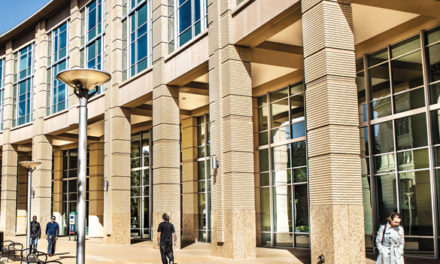Homeless Solutions
Why not build San Antonio center here?
By Craig Powell
August 2019
Editor’s Note: The following article, originally published in October 2017, has been updated with the latest data.
I first learned about Haven for Hope, a unique homeless facility in San Antonio, Texas, from a close friend, Jill McDonnell. Jill is a professional photographer. Her passion is capturing extraordinary images of homeless people in Sacramento.
Jill is no softheaded bleeding heart. She has a clear-eyed realist’s view of the complexity of human nature, both its positive and negative elements. She’s closely attuned to the players, policies and politics involved with homeless issues in Sacramento. Because she has an abiding human compassion and innate common sense (an all-too-rare combination), I sought her perspective when I began studying the city’s stumbling responses to the homelessness problem.
She had one piece of advice: Go to San Antonio.
What she meant was that I should visit Haven for Hope, a 22-acre comprehensive homeless facility near downtown San Antonio. In 2017, I spent a week in that city while attending a conference. I scheduled an extended tour of Haven for Hope with Laura Calderon, the organization’s insightful and frank director of external relations.
Overview of Haven for Hope
Haven for Hope, built in 2010, is the largest facility of its kind, caring for almost 1,600 people nightly in a sprawling campus. It’s the nation’s most highly acclaimed homeless facility. Officials from more than 300 U.S. cities have visited to learn how the Haven model works and to assess whether its approach would be a good fit for their communities. Haven differs from other facilities in its innovative two-step approach to caring for the homeless, as well as its comprehensive approach to helping homeless individuals transform their lives. Haven for Hope is not in the business of just warehousing people.
Haven’s Transformational Campus
Haven for Hope is clear about its mission: to transform lives, not merely ameliorate the immediate problem of homelessness. Unlike most homeless programs, Haven is focused on aggressively addressing the root causes of homelessness, which are as varied as the colors of the rainbow: drug addiction, alcoholism, mental illness, bad luck, medical crises, sudden joblessness, domestic abuse, domestic disintegration, the unique challenges facing disconnected LBGTQ youth, and the rebellious among us who choose a life off the grid.
The heavy lifting of helping people work through the root causes of homelessness takes place in the “Transformational Campus,” a series of renovated industrial warehouses housing 65 affiliated service agencies and nonprofits that implement the highly individualized care plans crafted by case managers for each new participant. Eighty-five referral partners provide services to Haven’s residents. There are typically 1,000 volunteers working on the campus each month.

First Step: The Courtyard
The typical entry point is through the outdoor Courtyard. It is a large, open-air covered patio. It’s equipped with heavy-duty fans and misters to keep down ambient temperatures. Indoor facilities are made available to Courtyard occupants during periods of inclement weather. Only basic services are provided in the Courtyard: regular meals, laundry access, sleeping pads, health care triage and mental health care services, as well as lockers for personal belongings.
Sobriety is not a requirement at the Courtyard. It is a largely safe resting and sleeping place for those not ready to meet the requirements for entry into the Transformational Campus. Petty theft is a problem. The Courtyard is patrolled by Haven security and off-duty San Antonio police officers.
If someone is willing to commit to sobriety and agrees to comply with the Transformational Campus’ rules for participation, they are typically admitted to the Transformational Campus. Once admitted, they are closely monitored in their early days to ensure they remain sober. Haven staffers acknowledge slips are often a part of recovery. They don’t result in summary dismissal. Staffers are committed to each resident’s success.
More than 6,000 people have moved from the Courtyard to higher levels of residential care, including sobriety programs, mental health and other forms of supportive or permanent housing, since Haven’s opening in 2010. The contrast between the basic Courtyard and the more supportive Transformational Campus provides a strong incentive for homeless people to transfer to the Campus.
Success in Ending Homelessness: Employment of Residents
In the program’s first seven years, 3,682 people exited the Transformational Campus and moved to permanent housing. The average length of stay was 162 days for single people and 134 days for families. After one year, 90 percent of people who exited with a housing placement did not return to homelessness, an extraordinary track record. More than 2,262 individuals attained employment in Haven’s first seven years.
In the January 2019 federally mandated “point-in-time” count, Haven had 853 people in Transformational Campus facilities, and 565 in the open Courtyard.
Impact on Residents and San Antonio Community
How effective has Haven for Hope been in reducing homelessness in San Antonio? After Haven’s first year of operation, the point-in-time count in downtown San Antonio declined from 738 to 254. In the January 2019 count, the number was 252.
Because Haven provides comprehensive health care to residents and nonresidents, including mental health programs, detox services and recovery programs, it has become the care facility of choice for San Antonio police dealing with public inebriates.
More than 50,000 people have received such potentially life-saving detox services at Haven’s Restoration Center, relieving city and county jails, emergency rooms and courtrooms of an estimated $97 million in taxpayer costs, according to Haven estimates.
Haven’s In-House Recovery Program provides housing and support for those with drug and alcohol addictions. Since opening in October 2010, the program has had a success rate of 56 percent, which exceeds the average completion rate of 44 percent for such programs. Through its in-house mental health wellness programs, one for men and another for women, Haven has a combined success rate of 44 percent.
Haven has developed joint projects with San Antonio Police, including Haven’s Jail Release Program and the Center for Health Care Services’ Jail Diversion Program, which has resulted in sharp drops in the number of jail bookings. Jail bookings dropped 3,300 in Haven’s first year, with drops of 800 and 1,700 in 2016 and 2017.
Haven’s Restoration Center allows police to quickly divert injured prisoners to the center’s on-site minor-emergency clinic instead of to hospital ERs, minimizing the time officers spend in emergency rooms. The city estimates that the value of getting those officers quickly back on the street is approximately $2 million annually.
Most health clinics operating at Haven are open to the public free of charge; the public makes more than 40,000 visits to Haven for medical, dental and vision care services annually.
Engaged Private Sector Funded Most of Development Costs
Haven for Hope was built at a cost of $100.5 million. Here’s a stunning fact: More than 60 percent of its construction cost ($60.1 million) was funded by private sources ($22.5 million by the city of San Antonio, $11 million by Bexar County and $6.1 million by the state of Texas). Its construction served to create 190 permanent new jobs at Haven and another 150 new jobs created by its affiliate nonprofits, as well as 465 construction jobs.
Haven for Hope is heavily supported by the private sector: 50 percent of its $18.6 million annual operating budget is funding by private-sector donors, 27 percent by the state, 16 percent by city government, 4 percent by county government and 3 percent by the federal government. Of the private-sector sources of operations funding, the United Way contributes 8 percent, private contributions account for 21 percent, and 21 percent is provided by two private foundations, one of which is largely funded by the extraordinary visionary who created Haven for Hope, William E. Greehey, retired CEO of San Antonio-based Valero Energy.
Haven’s Secret Sauce: Business Community Leadership
In 2005, Greehey was nearing retirement and eager to help his community. According to an interview in the Los Angeles Times, he was inspired by a local television report on homelessness. “What I saw was that all we were doing is recycling the homeless people that would go to jail, come out of jail, get sick, go to the emergency room, get treated, get back to the street. We weren’t doing anything to address the root cause of why these people were homeless,” he said.
He spent the next five years developing his ambitious vision for Haven for Hope, a first-of-its-kind facility in terms of scope of services, size and degree of collaboration required by nonprofit and agency partners. He brought San Antonio’s mayor and city manager on board as early supporters. He corralled support from San Antonio’s business community and leaders, and experts in homeless services. He used his experience in industrial development and executive leadership to move his vision from dream to reality.
A Model Sacramento Should Consider
In my August 2017 column, I recounted the failure of homelessness policies in almost every major city on the West Coast, while public spending by West Coast cities to “solve” their homeless problem has been skyrocketing. In my September 2017 column, I chronicled the seemingly endless fights and disagreements in Sacramento over how to best deal with homeless issues, with Mayor Darrell Steinberg scrambling to spend money as quickly as possible on largely untested scattershot approaches. Since then, the problem has only become worse.
San Antonio’s model, Haven for Hope, is transforming lives, dramatically reducing homelessness, improving health outcomes, moving people into permanent housing, increasing employment and dramatically reducing costs to taxpayers.
A Haven for Hope facility in Sacramento would require strong private-sector leadership, free of the political angles that color and contaminate the search for sound solutions. Private-sector capital is essential to bringing such a vision to life in Sacramento.
The Sacramento business community has no shortage of visionary, talented business leaders. Here is a perfect opportunity for one of them to make a real difference.
Craig Powell is a retired attorney, businessman, community activist and president of Eye on Sacramento, a civic watchdog and policy group. He can be reached at craig@eyeonsacramento.org or (916) 718-3030. Follow us on Facebook, Twitter and Instagram: @insidesacramento.







































